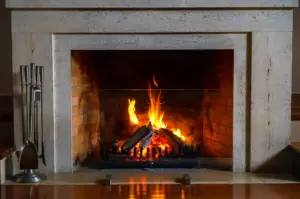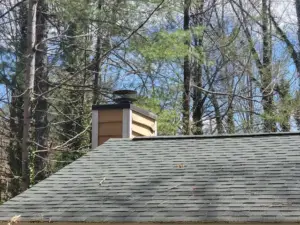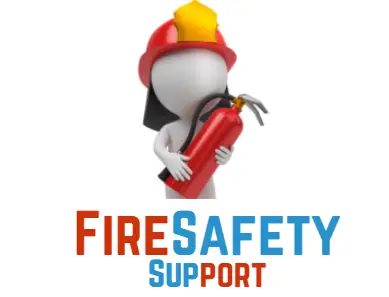A fireplace is composed of key elements like the firebox, chimney, and ventilation system. The hearth holds logs, while back panels ensure a secure burn surface.
Mantels provide support and style, and aprons control fire spread. Dampers regulate airflow, and the smoke shelf and flue manage smoke for a safe experience. These components together create the functional and beautiful essence of a fireplace.
However, there are many more things to learn about the parts of a fireplace. Keep on reading our article to know all the details!
Key Takeaways
- Understanding fireplace parts like the firebox, chimney, and ventilation system is crucial for efficient and safe operation.
- Seven popular fireplace types, including wood-burning, gas, electric, and masonry, offer diverse options for homeowners with different preferences.
- Keep your fireplace safe by regularly cleaning, ensuring good condition, checking for hazards, and installing a fire alarm for added protection.
What Is A Fireplace?
A fireplace is an appliance that uses fire to heat homes. It’s the most common form of heating in the United States, and it’s the main source of heat in many countries around the world.
In general, a fireplace is a small box that contains a firebox and flue. The firebox can be made from stone, bricks, or concrete blocks, but it doesn’t have to be as long as the room it’s in.
The flue connects the firebox to the chimney. Most people use wood for their fires because it burns slowly and evenly.

Understanding The Parts Of A Fireplace And Their Function
The fireplace is the focal point of your living room and has many parts. The fireplace is a box-like structure that can be either free-standing or built into the wall.
It is made of stone, brick, or concrete, and it is surrounded by a hearth, which can be made from stone, brick, or concrete.
There are different parts of your fireplace and their functions that you need to know.
To start with, let’s check out the central parts of a fireplace:
1. Firebox:
Fireboxes are the heart of your fireplace. They are where the fire is “burned” and kept going for hours, days, or even weeks. Fireboxes can be made out of many different materials, but in most cases, they are made from concrete or brick.
Note: The firebox is the same as the insert in gas and electric fireplaces.
2. Chimney:
The chimney is an important part of your fireplace. The purpose of a chimney is to carry the smoke away from where it was created in order to prevent fire from spreading throughout the home, which would cause damage and risk injury.

The smoke and fumes produced by burning wood or other fuels can be toxic if inhaled too deeply.
However, the necessity of a chimney will depend on the type of fireplace you have. For example, a chimney in a gas fireplace is not very common.
3. Ventilation System:
The ventilation system of your fireplace is designed to keep your fireplace interior from getting too hot. When you use a fireplace, the smoke from the burning logs goes up through the chimney and into the ventilation system.
Also, the ventilation system has a fan that blows air through the chimney to keep it open. This helps prevent smoke from building up inside and making it difficult for you to breathe.
The fan can also be used as an alarm if there is a problem with the chimney itself, such as a broken flue or damaged vent cap.
If there is a problem with your fan, it will sound an alarm so that you can fix it right away before something happens to the house or yourself.
4. Hearth:
The hearth is the center of your fireplace. It provides a place to put logs, kindling, and coal. The hearth should be at least 4″ from the wall, and it should be at least 18″ from any adjacent wall to prevent heat loss.
You can also use an ash pan on top of your hearth if you want to get rid of ash quickly.
5. Fuel:
The fuel of a fireplace is one of the most important parts of a fire. It is what gives you heat and light, and it’s also what makes sure that your fire doesn’t go out.
The fuel can be anything from wood to gas, but if you want to make sure your fireplace keeps going, you’ll want to invest in something that burns cleanly and efficiently.
6. Screen:
The glass screen is a decorative piece of glass that is placed over the fireplace opening. It is used to create a pleasant environment and it also protects the opening from being damaged by the heat.
The purpose of this part is to protect the opening from getting burned or damaged by excessive heat and smoke from the fire. It also adds aesthetics to your home decorating scheme by creating an elegant look for your fireplace
Now, let us check some of the surrounds of the fireplace.
7. Back panel:
The back panel of your fireplace is a major component. It connects the front and back sides of the fireplace and provides an even surface for your fire to burn on.
The back panel should be made from durable materials, like concrete or stone, so it can withstand the heat of your fire.
8. Mantel:
The mantel is the shelf that holds the fireplace. It must be strong enough to hold the weight of any objects placed on it, and it should also support the chimney itself. The mantel should be constructed from stone or brick and covered with a smooth finish.
9. Apron:
The apron is a piece of wood that hangs over the fireplace and helps to keep the fire from spreading. The fire is usually built on top of an iron plate, which sits on top of the apron.
The purpose of an apron is to keep the fire from spreading too far, so it can’t damage anything else in your house. If you’re going to build a new fireplace, you’ll need to buy an apron, but if you already have one, it’s probably in good shape and can be reused.
10. Throat:
The throat is the part of the fireplace where the fire burns. It’s a space that allows you to adjust the flame height and temperature. It’s generally recommended that you use a screen or grate to protect your rug, couch, and other things in your home.
11. Damper:
A damper is a device used to regulate the flow of air in a fire. A damper works by closing off airflow to one section of a fireplace while allowing air to flow freely through another.
The damper can be opened and closed to control airflow based on your needs, such as whether you want more heat or less heat.
12. Smoke Shelf:
The smoke shelf is located in the back of the fireplace and acts as a wall between the firebox and the rest of your room.
This area is used to store wood or other fuels that are used to burn in the firebox. You can also use it to store logs or kindling if you do not want them lying around on your floor.
13. Smoke chamber:
The smoke chamber is a space that contains burning wood. It traps the smoke and prevents it from being released into the room.
The smoke chamber is usually located directly above the firebox, but it can also be located at the top of a chimney or in an adjoining room.
14. Flue:
A flue is a pipe that connects your fireplace to the chimney. Flues are used in conjunction with vents, chimneys, and fireplaces.
The purpose of the flue is to carry ash and other gases produced by the burning of wood or other fuel up into the chimney where they can be released.
15. Liner:
The liner is the part of the fireplace that is made of fire-resistant material like steel or cast iron. It protects the surface of the mantel or hearth from heat loss, which would damage the surrounding wall.
16. Lintel:
The lintel is the part of a fireplace that rests directly above the hearth. It’s often made of stone but can be made from any material that resists heat well. The purpose of the lintel is to hold up the door or window above it.
17. Crown:
The crown of your fireplace is the section that surrounds the top of the firebox. It’s often made of metal or stone, but it can also be made from a combination of materials.
The crown can be decorative, or functional. In some cases, it’s there to protect the firebox and keep smoke from escaping. In other cases, it’s used to create decorative effects like flame or smoke rings.
18. Flashing:
Flashing is a safety feature that ensures the fireplace is off at all times. If there is smoke or flames, the flashing will turn on, which means the fire is not burning. The flashing also helps to prevent fires from spreading to other parts of your home.
It works like a shutoff valve for your fireplace. If there’s smoke or flames, it activates and prevents them from spreading to other parts of the house.
Popular Types of Fireplaces
There are numerous fireplace options you can consider. Ultimately, it’s crucial to pick the one that suits your style and practical needs. Let’s dive into the world of fireplaces with these seven popular types, each bringing its unique charm to your space.
1. Wood-Burning Elegance:
If you’re drawn to old-world charm and a cozy ambiance, a wood-burning fireplace is a timeless choice.
However, be mindful of the maintenance involved, including annual cleanings and wood chopping. While some adore the charm, others might find it a bit of a hassle.
2. Gas Convenience:
For the charm of a flame at the flick of a switch, consider a gas fireplace. Installation is usually easier than wood-burning alternatives, and they demand less upkeep.
Gas fireplaces are eco-friendly, burning efficiently without emitting ash and soot. Keep an eye on operating costs depending on natural gas prices in your area.
3. Electric Modernity:
Sleek and modern, electric fireplaces offer a safe, affordable, and zero-emission solution. They’re easy to install, don’t require ventilation, and allow for customizable flame displays. While lacking the nostalgic charm, they make up for it in convenience.
4. Double-Sided Sophistication:
Double-sided fireplaces create a captivating visual by allowing you to see through into the next room.
Perfect for large spaces or creating a flow between living areas and outdoor patios, they efficiently heat two areas with one fireplace. An elegant and functional design choice.
5. Masonry Classic:
Built from brick or stone, masonry fireplaces are timeless classics. Ideal for new builds and larger projects, they might be cost-prohibitive for smaller renovations. They become a seamless part of your home’s structure, adding enduring charm.
6. Mason-Lite:
For the visual appeal of a full masonry fireplace with easier installation, consider Mason-Lite or Isokern prefabricated units. Lighter in weight and customizable with surrounds, these units offer a cost-effective alternative to traditional masonry.
7. Fireplace Inserts:
Looking to retrofit an existing fireplace? Fireplace inserts are metal stoves that can accommodate wood, gas, or electric options. They provide ventilation solutions and offer an easy conversion for your fireplace.
How To Maintain A Fireplace
Taking care of your fireplace doesn’t have to be a daunting task. With these easy maintenance tips, you can enjoy a beautiful, functional fireplace year-round.
Routine Cleaning: Give your fireplace a quick clean with a damp cloth to remove accumulated dirt. Use warm water and a soft brush if needed. This simple routine will keep your fireplace looking inviting all year long.
Annual Chimney Cleaning: Schedule an annual chimney cleaning using a brush and vacuum. Mix baking soda with water to scrub away any residue inside the flue. This ensures efficient ventilation and prevents any build-up that could hinder the performance of your fireplace.
Remove Ash and Soot: Regularly sweep away ash and soot from around the fireplace using a broom or a shop vacuum cleaner. Keep the area neat, and you’ll enhance both safety and aesthetics.
Protect with a Cap Check: Ensure your chimney cap is in good condition and free of soot. Periodically inspect for tears or holes. Seal any gaps with putty or caulk to prevent unwanted guests like birds or debris from entering.
Fire Safety Inspection: Thoroughly inspect your chimney for cracks or crevices that could pose a fire hazard if left unattended. Avoid leaving flammable items nearby and always confirm that fires are fully extinguished before leaving the room.
Bonus: To ensure fire safety in your house, you should also know how to put out oven fires.
Flue Maintenance: Keep the flue clean by using a wire brush or a small paintbrush with steel bristles. Regularly clear away soot and debris to ensure optimal functioning and safety.
Smooth Operation with Lubrication: Don’t overlook the importance of well-lubricated door hinges. Maintain them to allow smooth opening and closing. This simple step ensures proper functioning and longevity.
How to Prevent A Fireplace Hazard
A fireplace is one of the most welcoming and relaxing places in your home. But it can also be a dangerous place to have burning, especially if you have children or pets.
Here are a few tips on how to keep your family safe from the dangers of fireplaces.
Keep It Clean:
If there are any cobwebs or other debris on the roof of your fireplace, remove them immediately. This could allow for more heat to escape through the chimney, increasing the chances of starting a fire.
Use Safety Precautions:
Make sure that there is nothing blocking any openings around your fireplace and make sure everything is clear away from any nearby furniture or walls.
Ensure Good Condition:
If you notice that there are cracks or holes in your chimney, make sure they’re patched up as soon as possible so that no more heat escapes through them than necessary.
You should also regularly check for loose bricks or other debris inside your fireplace’s chimney that could cause problems with airflow.
Check for Potential Hazards:
Make sure there aren’t any loose materials or objects scattered around the fireplace that could pose a fire hazard such as pieces of wood that could start a fire with just one spark.
Also, make sure there are no holes in the hearth where embers could escape during use and cause an entire room to burn down.
Use Fire Alarm:
Install an automatic fire alarm system in your home so it will alert you if there is any kind of fire in the area where the fireplace is located that way, even if something gets out of control (like a candle), you’ll know what’s happening right away and can take appropriate action quickly.
Conclusion
It is important that you know the parts of a fireplace as that will help you know the right way to operate one. Knowing the parts of a fireplace is important because it can help you make more informed decisions about your home.
A fireplace is made up of several different parts, and knowing how they work together will help you make better decisions about whether or not to replace your current fireplace.

